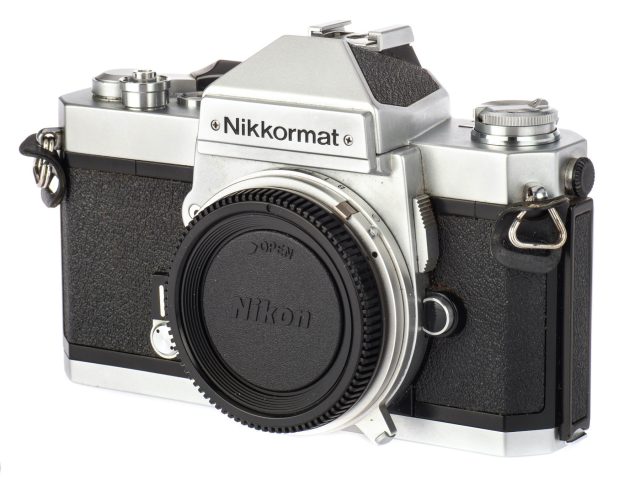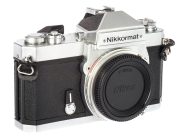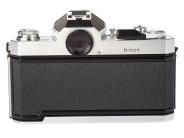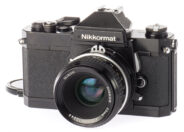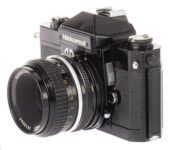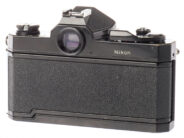Announced
Production status
System
Nikon F system cameras
- Nikkorex F
- Nikkormat EL
- Nikkormat ELW
- Nikkormat FS
- Nikkormat FT
- Nikkormat FT2
- Nikkormat FT3
- Nikkormat FTN
- Nikon D3
- Nikon D3s
- Nikon D3X
- Nikon D4
- Nikon D4s
- Nikon D5
- Nikon D6
- Nikon D600
- Nikon D610
- Nikon D700
- Nikon D750
- Nikon D780
- Nikon D800
- Nikon D800E
- Nikon D810
- Nikon D850
- Nikon Df
- Nikon EL2
- Nikon EM
- Nikon F
- Nikon F100
- Nikon F2
- Nikon F3
- Nikon F4
- Nikon F5
- Nikon F6
- Nikon FA
- Nikon FE
- Nikon FE10
- Nikon FE2
- Nikon FG
- Nikon FG-20
- Nikon FM
- Nikon FM10
- Nikon FM2
- Nikon FM2/T
- Nikon FM3A
- Nikon N2000
- Nikon N2020
- Nikon N4004
- Nikon N4004S
- Nikon N50
- Nikon N5005
- Nikon N55
- Nikon N60
- Nikon N6000
- Nikon N6006
- Nikon N65
- Nikon N70
- Nikon N75
- Nikon N80
- Nikon N8008
- Nikon N8008S
- Nikon N90
- Nikon N90S
Nikkormat FT3
35mm MF film SLR camera • Discontinued
Specification
| Format: | |
| 35mm full frame | |
Film type: | 135 cartridge-loaded film |
| Nikon F [46.5mm] | |
| Shutter: | |
Type: | Focal-plane |
Model: | Mechanical |
Speeds: | 1 - 1/1000 + B |
| Exposure: | |
Exposure metering: | Through-the-lens (TTL), open-aperture |
Exposure modes: | Manual |
| Physical characteristics: | |
Weight: | 750g |
Dimensions: | 148x96x54mm |
Manufacturer description #1
Nikkormat single-lens-reflex cameras are built to Nikon standards of advanced technology and rugged precision. Moderately priced, they offer economical entry into the Nikon system. They accept all interchangeable Nikkor lenses and most Nikon accessories. Features common to all current Nikkormat models include:
- Center-Weighted Through-the-Lens CdS Metering with more than 55 Nikkor lenses.
- Rugged All Metal, Vertical-Travel, Focal Plane Shutter with speeds to 1/1000th second.
- Full Flash Capability with "X" synch to 1/125th second, "M" synch to 1/1000th; built-in hot shoe and PC outlet; special flash safety features.
- Large, Bright Viewfinder shows comprehensive exposure information including shutter speeds, meter needle and reference markers.
- Fast, Easy Operation to capture every photographic opportunity.
There are two basic series of Nikkormat cameras. The Nikkormat FT3 provides the convenience and accuracy of automatic maximum aperture indexing and full-aperture metering with all AI-Nikkor lenses, from 6mm to 600mm. (Note: Most previous Auto-Nikkors can be converted for AI operation.) Other models in the Nikkormat family (including the FT2, EL, and ELW) are designed for manual aperture indexing as the lens is attached and provide full-aperture metering with all Nikkor lenses with meter-coupling shoe (including all AI-Nikkor lenses).
Nikkormat FT2 and FT3 feature accurate, through-the-Iens, match-needle metering, controlled by simply adjusting the lens aperture or shutter speed. Their rugged metal shutters provide speeds from 1 to 1/1000th second plus "B." While the most economical of Nikon-system cameras, these models are so reliable and versatile that many are owned by professional photographers.
Nikon quality and design ingenuity are evident in all Nikkormat cameras. All share the Nikon center-weighted meter system, acknowledged to be the most reliable in the vast majority of photographic situations. The meter switch is activated by the film transport lever - also a Nikon innovation - for added speed and convenience. Bright, comfortable viewing and pin-point focusing are assured by the famous Nikon Type K finder screen with 3-way focus check: central split-image rangefinder, surrounding microprism collar, and overall matte Fresnel field. A special control system holds the film truly flat during exposure for sharpest possible images.
Manufacturer description #2
Nikkormat FT3 is an easy-handling precision camera that combines fast, uncomplicated operation with a full complement of built-in features, ruggedly reliable performance, and versatility far beyond its economical price. Ideal for any beginning SLR photographer, the FT3 also meets the needs of advanced hobbyists and even professionals - by itself or as an inexpensive extra body for anyone's personal Nikon system.
Constantly Picture-Ready
The FT3 is designed to permit all picture-taking operations with the camera held at eye-level. Focusing, lens aperture and shutter adjustments are quickly made with the left hand; film advance and shutter release (also depth·of-field preview, when desired) with the right.
Center-Weighted Meter System
Designed by Nikon and acknowledged as the most consistently accurate for through-the-lens exposure control. Two sensitive CdS cells observe the entire picture area but derive more than half of their exposure information from the central 12mm·diameter area, where the main subject is usually located. This helps compensate for overly bright or dark back grounds and, in most situations, provides accurate exposure with a single reading. The "weighted" area is precisely and uniformly centered in every FT3 camera, and readings are equally reliable whether the camera is held in horizontal or vertical position. The meter switch is activated by the film advance lever.
Automatic Maximum Aperture Indexing (AI)
With AI-Nikkor lenses, the FT3 meter is programmed automatically as the lens is attached to the camera with a quarter-turn. The photographer is then immediately ready for full-aperture metering. AI-Nikkors thus are instantly interchangeable. Stop-down metering, equally accurate, is provided with all other reflex-viewing lenses and other image-forming attachments. (Most earlier Auto-Nikkors can be converted for AI operation.)
Exposure Check Through The Finder
Correct exposure is indicated when meter needle is centered in bracket visible in the finder. Minus and plus markings indicate under and over-exposure settings. Selected shutter speed appears at bottom of finder, flanked by next higher and lower speeds.
...And From Above
Meter needle along with plus and minus markers is seen also in window on top of camera; helpful when camera is in low-level position, held overhead (upside down), or for closeup applications.
Nikon "K" Finder Screen
Combines optimum brightness and focusing ease. For quick, positive focus, you can use the central split-image rangefinder, the surrounding microprism collar, or any part of the entire finder area. Fresnel-type screen is evenly bright to edges, with no sacrifice in focusing accuracy. Circular outline shows "weighted" metering area. Eyepiece accepts all Nikon system screw-on finder accessories.
High-Speed Flash Synch
FT3 vertical-travel metal shutter (1 second to 1/1000th plus "B") provides electronic flash synch to 1/125th, reducing risk of "ghost" images that might be caused by bright, existing light at slower speeds; also synchs with "M" bulbs to 1/1000th sec. No synch adjustment is required for different types of flash.
Hot Shoe Plus PC Terminal
Shoe accepts Nikon and other flash units with standard cordless synch contact. Safety switch automatically turns shoe contact off when unit is removed, so there's no risk of annoying shock. For cord-type units and for off-camera flash, there is a single standard terminal, threaded for slip-proof Nikon screw-in cords (also accepts other PC cords).
Multi-Function Advance Lever
The plastic tip-cushioned lever (derived from the Nikon space cameras) advances the film, cocks the shutter and counts the exposures with a short 135 deg. sweep. It also switches the meter system on, at the 20 deg. stand-off position, and off when returned flush with the camera.
Special Film Flattening System
Nikon design goes to extreme lengths to assure maximum film flatness for sharpest possible pictures with the FT3: (1) stabilizer prevents film cartridge from wobbling; (2) film travels on extra-long, precision-ground, tecessed rails, (3) is held flat by over-size, polished pressure plate, aided by (4) special "anti-bellying" roller, and finally (5) winds onto fixed takeup spool emulsion-side out, further counteracting its natural "curl". Hinged back is structurally rigid and locks securely with a double catch.
Depth-Of-Field Preview
Permits checking pictorial effect at selected shooting aperture at touch of a button.
Self-Timer
Releases shutter automatically after approximately 10-second delay.
Nikkormat FT3 is supplied in satin chrome (Product No. 1832) or professional black finish (Product No. 1837).
Manufacturer description #3
CAMERA TYPE: 35mm SLR with through-the-Iens CdS metering and interchangeable lenses.
LENSMOUNT: Stainless-steel Nikon bayonet accepts all Nikkor lenses 6mm-2000mm and all Nikon-mount accessories. Flange/film distance 46.5mm, Automatic diaphragm coupling.
EXPOSURE CONTROL: Through-the-Iens, match-needle readout with aperture or shutter priority.
METER SYSTEM: CdS cells concentrate 60% of sensitivity on central 12mm area shown by circle in finder; operates at full aperture with all AI-Nikkor lenses; stopdown measurement with non-AI lenses, attachments, or instruments. Automatic maximum aperture indexing with all AI-Nikkor lenses.
METER RANGES: ASA 12-1600; EV 3 to 17 (with ASA 100 film and f1.4 lens). Full-aperture coupling range: f1.2-f32.
SHUTTER: All-metal vertical-travel focal plane; speeds "B", 1, 1/2, 1/4, 1/8, 1/15, 1/30, 1/60, 1/125, 1/250, 1/500, and 1/1000th second.
FLASH SYNCHRONIZATION: "X" synch at "B" to -1/125th second; "M" synch at "B", 1-1/30th, 1/250-1/1000th second; automatic synch adjustment as shutter speed is set.
FLASH CONTACTS: Built-in hot shoe with automatic safety switch; single PC outlet accepts Nikon screw-on or conventional PC cords.
VIEWFINDER: Built-in pentaprism finder with -1.0 diopter correction; information display includes meter needle, under/over exposure indicators, shutter speed in use, and adjacent higher and lower speeds. Needle on camera top permits exposure check from above.
FOCUSING SCREEN: Fixed Nikon Type K screen with 3mm-diameter split-image rangefinder, 1mm microprism circle plus overall matte Fresnel area; large circle shows center-weighted measurement area.
REFLEX MIRROR: Oversize instant-return type with independent locking control.
FILM LOADING: Multi-slotted take-up spool, hinged back and additive automatic-reset exposure counter for fast loading.
FILM TRANSPORT: Single-stroke lever advances film, winds shutter, switches meter on, and counts exposures in 135 deg. action; may be left at "ready" position 20 deg. from camera body to activate meter; when folded flush, lever turns meter off.
FILM REWIND: Rewind-release button on camera baseplate; fold-out rewind crank pulls up to open camera back.
BATTERY TYPE: Two 1.5v silver oxide batteries (Eveready S76 or equivalent) power meter.
OTHER FEATURES: Depth-of-field preview; stainless-steel reinforced neckstrap eyelets; built-in self timer with variable delay to approximately 10 seconds.
Similar cameras (4)
35mm full frame • Manual focus • Film • Singe-lens reflex • Nikon F mount
| Model | Shutter | Metering | Modes | Year |
|---|---|---|---|---|
| Kiev-17 aka Киев-17 |
M, 1/1000 | -- | M | 1978 ● |
| Kiev-19 aka Киев-19 |
M, 1/500 | TTL • WA | M | 1985 ● |
| Kiev-19M aka Киев-19М |
M, 1/500 | TTL • OA | M | 1988 ● |
| Kiev-20 aka Киев-20 |
M, 1/1000 | TTL • OA | M | 1983 ● |
